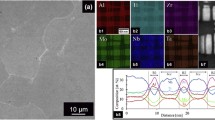Abstract
The possible high-temperature corrosion modes ofbinary solid-solution alloys forming two immisciblecompounds by a single oxidant include (1) the exclusivegrowth of external scales of the most-noble component, which may or may not be associated with theinternal oxidation of the most-reactive component, (2)the formation of composite external scales containing amixture of the two compounds, or finally (3) the exclusive growth of the most-stable compound asan external scale. The conditions for the stability ofeach scale structure depend on a number of thermodynamicand kinetics parameters, whose effects are examined quantitatively in this paper. Theconditions for the stability of the various structuresand the criteria for the transitions among them are alsoexamined. The maximum number of possible scale structures is four, but it can reduce to threeand, in some cases, only to two. In particular, theinternal oxidation of the most-reactive component maynot occur if the stabilities of the two oxides are not sufficiently different from eachother.
Similar content being viewed by others
REFERENCES
B. D. Bastow, G. C. Wood, and D. P. Whittle, Oxid. Met. 16, 1 (1981).
C. Wagner, Corros. Sci. 9, 91 (1969).
P. Kofstad, High Temperature Corrosion (Elsevier Applied Science, New York, 1988).
C. Wagner, Corros. Sci. 8, 889 (1968).
C. Wagner, J. Electrochem. Soc. 99, 369 (1952).
C. Wagner, Z. Elektrochem. 63, 772 (1959).
R. A. Rapp, Corrosion 21, 382 (1965).
F. Maak, Z. Metall. 52, 545 (1961).
F. Gesmundo and F. Viani, Oxid. Met. 25, 269 (1986).
A. Atkinson, Corros. Sci. 22, 87 (1982).
D. P. Whittle, D. J. Young, and W. W. Smeltzer, J. Electrochem. Soc. 123, 1073 (1976).
W. W. Smeltzer and D. P. Whittle, J. Electrochem. Soc. 125, 1116 (1978).
F. Gesmundo, P. Castello, F. Viani, and J. Philibert, Oxid. Met. 47, 91 (1997).
F. Gesmundo and M. Pereira, Oxid. Met. 47, 507 (1997).
B. Chattopahyay and G. C. Wood, Oxid. Met. 2, 373 (1970).
D. P. Whittle, in High Temperature Corrosion, R. A. Rapp, ed. (NACE, Houston, 1983), p. 171.
G. C. Wood and F. H. Stott, Mater. Sci. Technol. 3, 519 (1987).
R. A. Rapp, Acta Metall. 9, 730 (1961).
G. Bohm and M. Kahlweit, Acta Metall. 12, 641 (1964).
F. Gesmundo, P. Castello, and F. Viani, Oxid. Met. 46, 383 (1996).
F. Gesmundo, P. Castello, and F. Viani, Oxid. Met. 47, 215 (1997).
F. Gesmundo, P. Nanni, and D. P. Whittle, J. Electrochem. Soc. 127, 1773 (1980).
M. J. Monteiro, Y. Niu, F. C. Rizzo, and F. Gesmundo, Oxid. Met. 43, 527 (1995).
M. C. Rebello, Y. Niu, F. C. Rizzo, and F. Gesmundo, Oxid. Met. 43, 561 (1995).
J. F. Oliveira, Y. Niu, F. C. Rizzo, and F. Gesmundo, Oxid. Met. 44, 399 (1995).
Y. Niu, F. Gesmundo, F. Viani, and W. T. Wu, Oxid. Met. 47, 21 (1997).
F. Gesmundo, Y. Niu, P. Castello, F. Viani, A. M. Huntz, and W. T. Wu, Corros. Sci. 38, 1295 (1996).
I. G. Wright, Oxidation of Iron-, Nickel-and Cobalt-Base Alloys (Metals and Ceramics Information Center, June, 1972).
H. Hindam and D. P. Whittle, Oxid. Met. 18, 245 (1982).
P. Kofstad and K. P. Lillerud, J. Electrochem. Soc. 127, 2410 (1980).
G. Zheng and D. J. Young, Oxid. Met. 42, 163 (1994).
F. Gesmundo, F. Viani, and Y. Niu, Oxid. Met. 42, 285 (1994).
A. W. Bowen and G. M. Leak, Met. Trans. 1, 1695 (1970).
T. Heumann and R. Imm, J. Phys. Chem. Solids 29, 1613 (1968).
J. Takada, K. Kashiwagi, and M. Adachi, J. Mater. Sci. 19, 3451 (1984).
P. G. Shewmon, Diffusion in Solids (McGraw-Hill, New York, 1963).
J. R. Weeton, Trans ASM 44, 436 (1952).
K. Hirano, R. P. Agarwala, B. L. Averbach, and M. Cohen, J. Appl. Phys. 33, 3049 (1962).
U. Seybolt and C. H. Mathewson, Trans. Met. Soc. AIME 117, 156 (1935).
P. J. Grundy and P. J. Nolan, J. Mater. Sci. Lett. 7, 1086 (1972).
K. Momma, H. Suto, and H. Oikawa, J. Jpn. Inst. Met. 28, 188 (1964).
D. F. Kalinovich, I. I. Kovenskii, and M. D. Smolin, Fiz., Tverd. Tela 10, 569 (1968).
J. W. Park and C. J. Alstatter, Met. Trans. 18A, 43 (1987).
F. S. Pettit, Trans. Met. Soc. AIME 239, 1296 (1967).
J. A. Nesbitt, J. Electrochem. Soc. 136, 1511 (1989).
H. Hindam and W. W. Smeltzer, J. Electrochem. Soc. 127, 1622 (1980).
A. Green and N. Swindells, Mater. Sci. Technol. 1, 101 (1985).
T. B. Massalski, J. L. Murry, L. H. Bennett, and H. Baker, eds., Binary Alloy Phase Diagrams (ASM, Materials Park, 1986).
F. Gesmundo, F. Viani, Y. Niu, and D. L. Douglass, Oxid. Met. 39, 197 (1993).
F. Gesmundo, F. Viani, and Y. Niu, Oxid. Met. 42, 409 (1994).
F. Gesmundo, F. Viani, Y. Niu, and D. L. Douglass, Oxid. Met. 42, 465 (1994).
F. Gesmundo, Y. Niu, and F. Viani, Oxid. Met. 43, 379 (1995).
F. Gesmundo, F. Viani, and Y. Niu, Oxid. Met. 45, 51 (1996).
F. Gesmundo, F. Viani, and Y. Niu, Oxid. Met. 47, 355 (1997).
F. H. Stott and G. C. Wood, Mater. Sci. Technol. 4, 1072 (1988).
D. P. Whittle and G. C. Wood, Corros. Sci. 8, 295 (1968).
S. J. Rothman and N. L. Peterson, Phys. Stat. Solidi 35, 305 (1969).
G. Brunel, G. Cizeron, and P. Lacombe, C.R. Acad. Sci. Paris C270, 393 (1970).
M. L. Narula, V. B. Tare, and W. L. Worrell, Met. Trans. 14B, 673 (1983).
J. Askill, Tracer Diffusion Data for Metals, Alloys, and Simple Oxides (IFIy Plenum, New York, 1970).
C. Wagner, J. Electrochem. Soc. 103, 627 (1956).
Rights and permissions
About this article
Cite this article
Gesmundo, F., Niu, Y. The Criteria for the Transitions Between the Various Oxidation Modes of Binary Solid-Solution Alloys Forming Immiscible Oxides at High Oxidant Pressures. Oxidation of Metals 50, 1–26 (1998). https://doi.org/10.1023/A:1018847116670
Issue Date:
DOI: https://doi.org/10.1023/A:1018847116670




